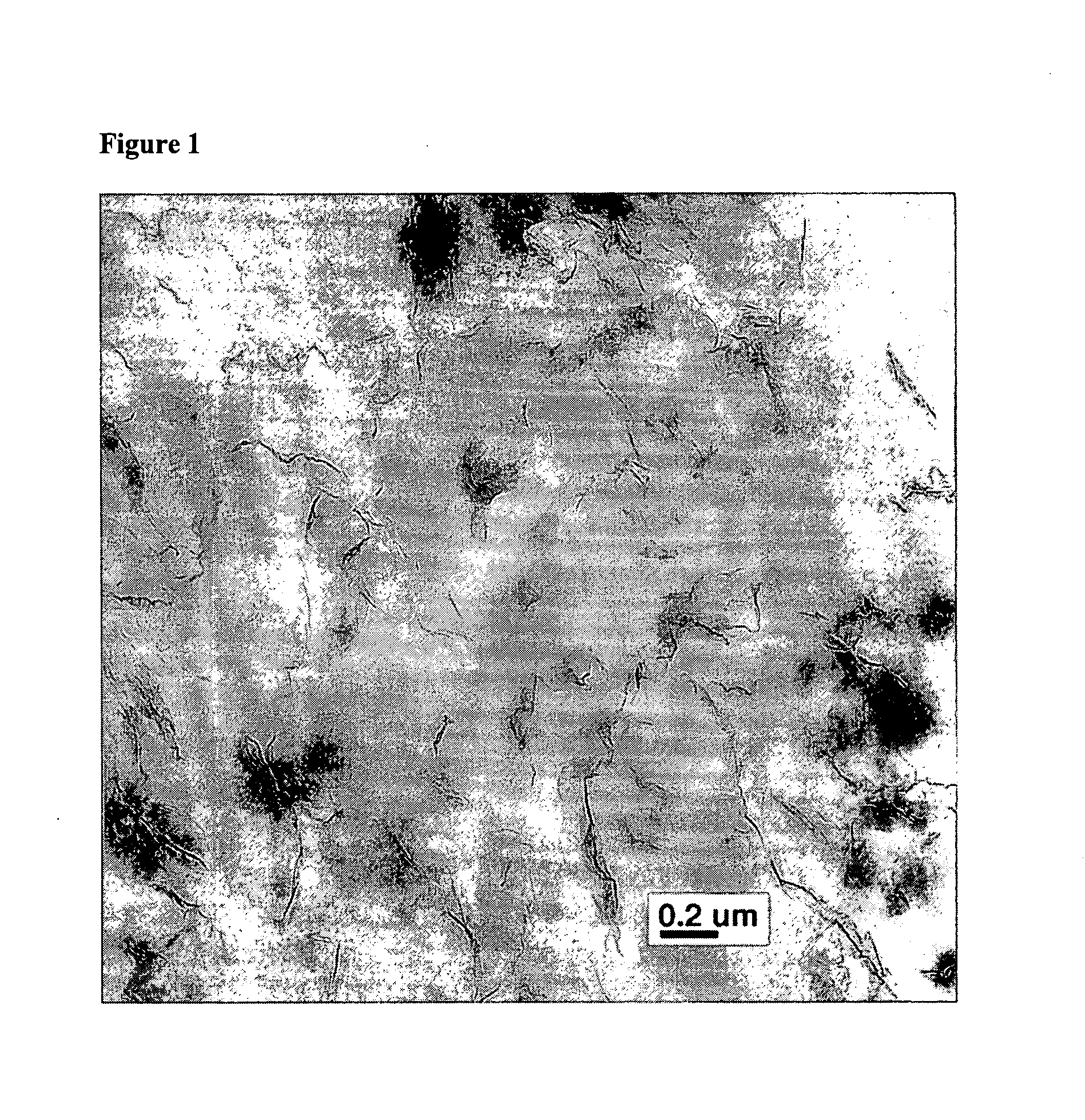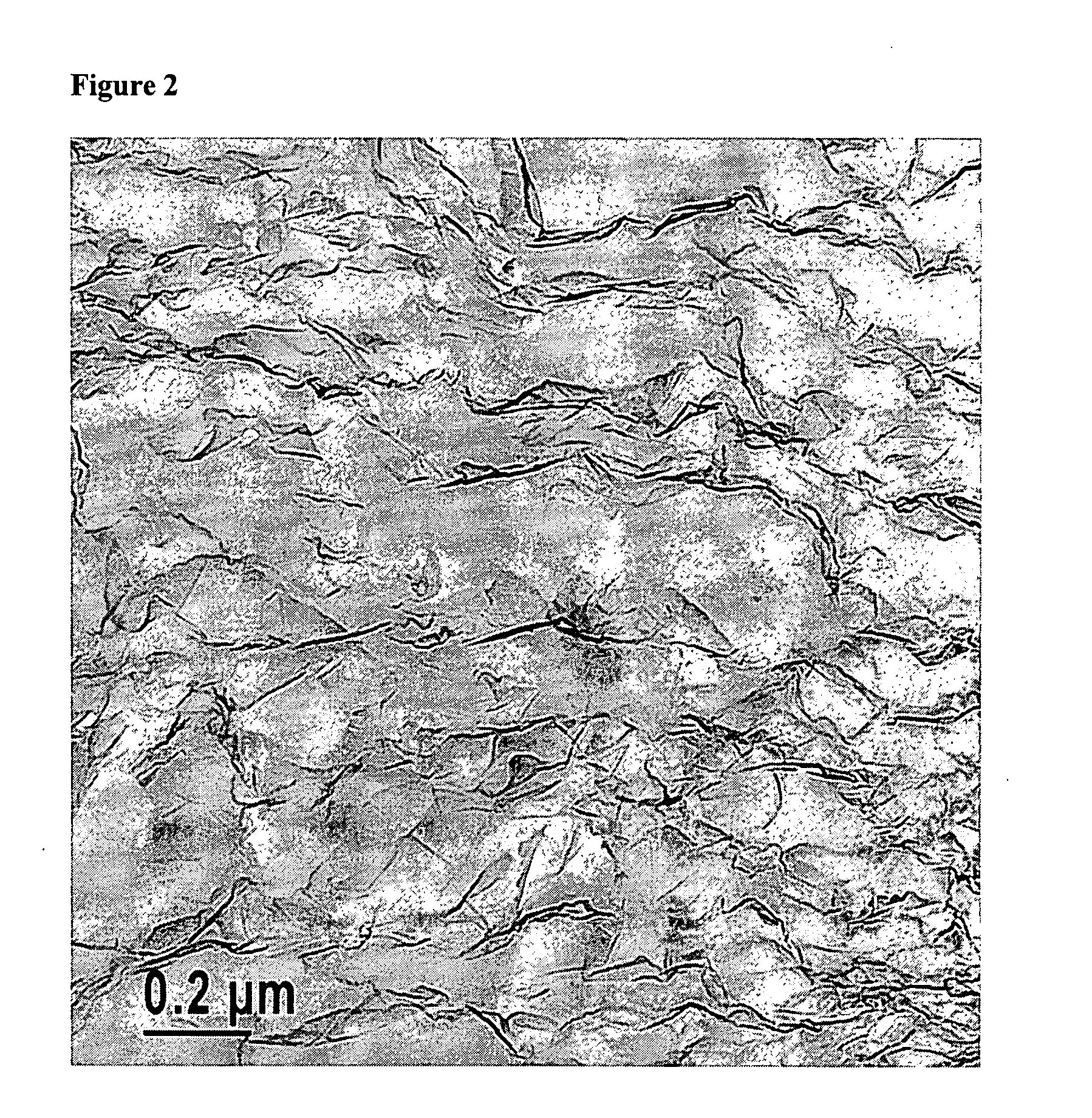Polymers filled with highly expanded graphite
a graphite and graphite technology, applied in special tyres, transportation and packaging, tyre parts, etc., can solve the problems of limited techniques that are available to form composites, unsuitable fibrous reinforcements, and high cost of fibers, so as to reduce the volume resistivity of composites and low loading
- Summary
- Abstract
- Description
- Claims
- Application Information
AI Technical Summary
Benefits of technology
Problems solved by technology
Method used
Image
Examples
example 1
[0069]50 g of an acid-intercalated graphite (GRAFGuard 160-50N) is added to a 3-necked flask 255 ml of concentrated sulfuric acid is added, followed by 135 ml of concentrated nitric acid. The mixture is chilled to 0-5° C. with stirring. 137.5 g of potassium chlorate is added in small portions, maintaining the temperature below 10° C. Following the addition of the potassium chlorate, the temperature of the mixture is raised to about 22° C. and held at that temperature for about 100 hours. This mixture congeals into a black foamy sludge during that time. Gas is vented from the flask, and 300 ml concentrated sulfuric acid is added with stirring for 30 minutes. The mixture is then added to 14 L of deionized water, and stirred for five minutes. The intercalated (and oxidized) graphite settles out of the aqueous phase and is removed by filtration. The filter cake is washed with two-1000 ml portions of 5% HCl and four-1000 ml portions of deionized water. The filter cake is then broken into...
example 2
[0075]An expanded graphite having a surface area of about 702 m2 / g is made using the general method described in Example 1. A powdered cyclic butylene terephthalate macrocyclic oligomer is dry blended with this material and 0.34% by weight distannoxane (0.3 moles / mole of macrocyclic oligomer) to provide a mixture containing 4% by weight expanded graphite. The mixture is starve-fed using a screw-type powder feeder into a reactive extrusion (REX) process to produce a composite. The REX process equipment consists of a co-rotating twin screw extruder (Werner Pfleiderer and Krupp, 25 mm, 38 L / D) equipped with a gear pump, a 1″ (2.5 cm) static mixer (Kenics), a 2.5″ (6.25 cm) filter (80 / 325 / 80 mesh) and a two-hole die downstream. The feeder and hopper are padded with inert gas during operation. The extruder is operated at 200-300 rpm, 15 lb / hr (6.8 kg / hr), and the temperature profile is increased from 50° C. in the initial section to 250° C. over the latter sections of the extruder and do...
example 3
[0080]Using the general process described in Example 1, multiple samples of GRAFGuard 160-50N acid-intercalated graphite particles are further intercalated with additional acid and potassium chlorate. Treatment times vary from 5 hours to 96 hours. Five-gram samples of the various intercalated graphite particles are expanded in the general manner described in Example 1, at 1000° C. for 30 seconds in air.
[0081]Samples treated for 5 hours expand to form an expanded graphite having a surface area of 102 m2 / g. Samples treated for 23 hours expand to assume a surface area of 275 m2 / g. Samples treated for 96 hours expand to assume a surface area of 702 m2 / g. A second sample that is not chopped prior to treatment (and thus has about a 1 cm particle size) is also treated for 96 hours, and assumes after expansion a surface area of 433 m2 / g. These experiments establish a correlation between treatment time (under the stated conditions) and surface area of the expanded graphite product, as well a...
PUM
| Property | Measurement | Unit |
|---|---|---|
| particle size | aaaaa | aaaaa |
| particle size | aaaaa | aaaaa |
| temperature | aaaaa | aaaaa |
Abstract
Description
Claims
Application Information
 Login to View More
Login to View More - R&D
- Intellectual Property
- Life Sciences
- Materials
- Tech Scout
- Unparalleled Data Quality
- Higher Quality Content
- 60% Fewer Hallucinations
Browse by: Latest US Patents, China's latest patents, Technical Efficacy Thesaurus, Application Domain, Technology Topic, Popular Technical Reports.
© 2025 PatSnap. All rights reserved.Legal|Privacy policy|Modern Slavery Act Transparency Statement|Sitemap|About US| Contact US: help@patsnap.com


